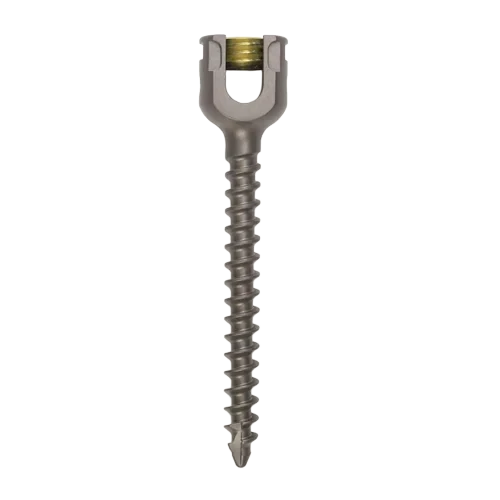E-mail iNfo@virkortho.shop Number +92-300-7477492

Monoaxial Screw
High-strength surgical screw for spinal fixation
Monoaxial Screw Introduction
Monoaxial Screw are used in a spinal fusion to add extra support and strength to the fusion while it heals. The screws themselves do not fixate the spinal segment, but act as firm anchor points that can then be connected with a rod.
Monoaxial Screw is specifically intended to provide internal fixation to stabilise and immobilise the spine. The screw is put into the vertebrae to encourage fusion, which is the process of connecting two or more vertebrae to form a solid bone mass.
Monoaxial Screw Sizes
Monoaxial Screw made from titanium, come in a variety of shapes and sizes to meet the demands of the patient.
Monoaxial Screws are available in various diameters and lengths.
Diameters: 4.5mm, 5mm, 5.5mm, 6.5mm and 7mm.
Lengths: 25mm, 30mm, 35mm, 40mm, 45mm, 50mm, 55mm and 60mm
Monoaxial Screw System intended to provide immobilization and stabilization of spinal segments in skeletally mature patients as an adjunct to fusion in the treatment of the following acute and chronic instabilities or deformities of the thoracic, lumbar, and sacral spine: degenerative spondylolisthesis with objective evidence of neurologic impairment, fracture, dislocation, scoliosis, kyphosis, spinal tumor, and failed previous fusion.
Monoaxial Screws are placed above and below the vertebrae that were fused. A rod is used to connect the screws which prevents movement and allows the bone graft to heal. After the bone graft grows, the screws and rods are no longer needed for stability and may be safely removed with a subsequent back surgery. Removal isn’t necessary unless they cause the patient discomfort.
Monoaxial Screw Benefits
Monoaxial Screws have transformed orthopaedic and spinal surgery by allowing for greater flexibility and adjustment during screw placement. Their ability to fit specific patient anatomy and optimise screw trajectory helps to increase fusion rates, stability, and spinal deformity repair. However, careful surgical planning, skill, and follow-up are required to maximise the advantages while minimising the hazards associated with these cutting-edge technologies.
There are various benefits of using Monoaxial Screw such as:
Placement Ease: The Monoaxial design makes screw placement easier, especially in difficult anatomical locations. Surgeons can coordinate the screw trajectory with the target anatomy, improving accuracy and lowering the chance of incorrect screw location.
Reduced Screw Strain: Monoaxial Screw evenly disperse forces along their length. This design decreases tension and pressure on the screw-bone interface, reducing the likelihood of screw loosening or breaking over time.
Improved Fusion Rates: Monoaxial Screw can help enhance fusion rates by allowing for appropriate screw positioning. The ability to customise screw trajectory enables surgeons to achieve better contact between the screw and bone, resulting in increased stability and the likelihood for successful fusion.
Correcting Spinal Deformities: Monoaxial Screws are especially useful in spine procedures to repair spinal deformities such as scoliosis or kyphosis. Because these screws are adjustable, surgeons can achieve desired alignment and curvature correction in three-dimensional space.
Spinal fusion surgery has advanced significantly over the years, with the development of numerous implants and techniques targeted at improving patient results. The Monoaxial Screw is one such invention.
Below is the benefits and applications of Monoaxial screws in spinal fusion surgeries.
Controlled Screw Placement:
Monoaxial Screw has a single axis of rotation and can only move in one direction. This feature allows for regulated and exact placement during surgery.
Increased Fusion Rates:
The major goal of spinal fusion surgery is to achieve a strong fusion between the vertebrae, which promotes stability and relieves discomfort. Monoaxial screws are essential in this process. The ability to precisely position the screws allows for ideal vertebral body alignment and compression, facilitating the fusion process. Polyaxial screws’ increased rigidity stimulates bone growth and fusion, resulting in better fusion rates and long-term outcomes for patients.
Reduced possibility of screw pullout:
Compared to conventional screws, Monoaxial screws feature a design that allows for a bigger contact area with the bone. The chance of the screw loosening or dislodging after surgery is decreased by the increased contact area, which also improves the screw’s pullout strength. The increased stability contributes to maintaining the spine’s proper alignment and reducing the risk of device failure, which enhances the fusion procedure’s overall success.
Patient-Specific Adaptability:
Because each patient’s spinal structure is different, it can be difficult to insert screws correctly. Monoaxial screws offer a variety of angulation choices to solve this problem. In order to achieve the best fixation and alignment, surgeons can modify the screw angle to correspond to the patient’s unique anatomical requirements. This ability to adjust to each patient encourages personalised surgical care, which leads to better outcomes and increased patient satisfaction.
Promoting Minimally Invasive Methods:
Minimally invasive spinal fusion treatments have grown in popularity because to benefits such as reduced tissue damage, quicker recovery durations, and less postoperative pain. Monoaxial screws are ideal for minimally invasive techniques because they allow for more manoeuvrability through fewer incisions. The ability to modify the screw angle allows surgeons to handle difficult anatomy and perform the fusion process with precision, even in places with limited access.
About
Exceptional orthopedic instruments and implants from Pakistan.
Contact
Portfolio
© 2025 All rights reserved.
Location
Quick Link